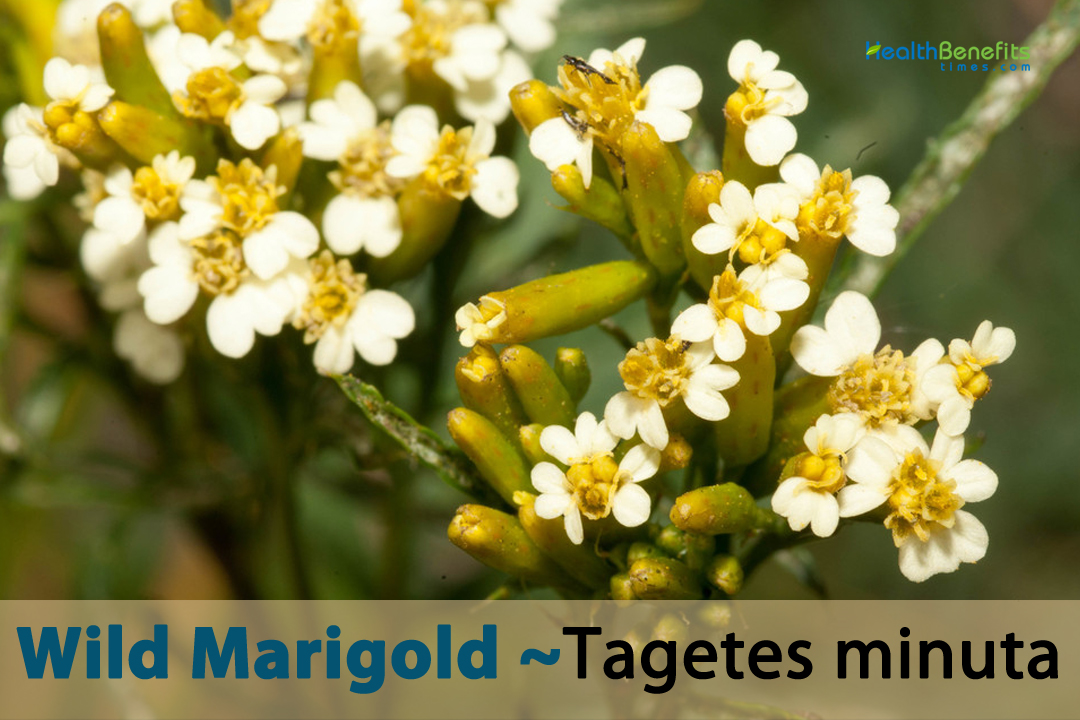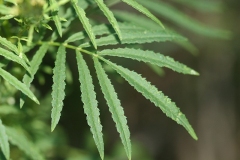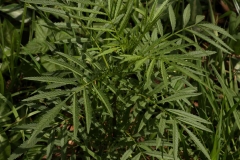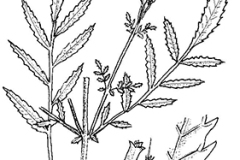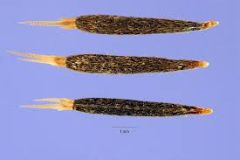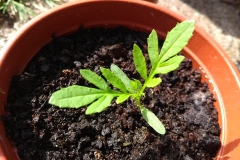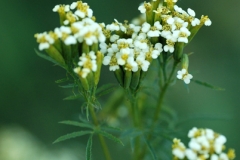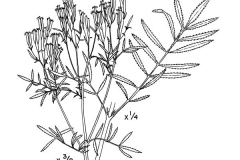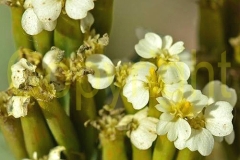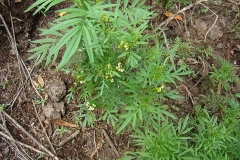| Wild Marigold Quick Facts | |
|---|---|
| Name: | Wild Marigold |
| Scientific Name: | Tagetes minuta |
| Origin | Temperate grasslands of southern South America but naturalized in Europe, Africa, Asia, Australia, New Zealand, and United States |
| Colors | Dark brown to black |
| Shapes | Black achenes, narrowly ellipsoid and hard seeds, 6-7 mm long |
| Name | Wild Marigold |
|---|---|
| Scientific Name | Tagetes minuta |
| Native | Temperate grasslands and mountain regions of southern South America but naturalized in Europe, Africa, Asia, Australia, New Zealand, and United States including Hawaii, Cape Verde, Madeira and Madagascar. It also grows in Ethiopia, Kenya, and other areas of East Africa, northern India and waste places of Spain. In Kenya it is found in Nairobi, Taita Hills, Voi-Nairobi road, Kaimosi, Masai Mara, Gatundu, Gathiuru Forest in Nyeri, Machakos. |
| Common Names | Aztec marigold, Mexican marigold, Muster John Henry, dwarf marigold, khaki-bush, stinking Roger, stinkweed, wild marigold, chinchilla, false marigold, little marigold, rattlepod, tall khaki weed, Southern marigold, Southern Cone Marigold, Minute marigold, Miniature marigold, Peruvian Black Mint, Huacatay, African marigold |
| Name in Other Languages | Afrikaans: Kakiebos Angola: Ekaibulo Arabic: Mukhmaliat daqiqa (مخملية دقيقة) Argentina: Chil chil Bengali: Gām̐dā phula (গাঁদা ফুল) Brazil: Chinchilla, coora, cravo de mato, margarita, rabo de foguete, rabo de rajao, suique, voadeira Catalan: Camamilla americana, camamilla de vinya, camomil.la d’América, comí d’América, herba pudent, menta americana, menta borda, menta d’América, milfulles, te pudent Chile: Quinchihue Chinese: Yìnjiā kǒngquè cǎo (印加孔雀草), Xiǎohuā wànshòu jú (小花万寿菊) Croatian: Kadifa Czech: Aksamitník menší Danish: Hvidgul fløjlsblomst, sydamerikansk morgenfrue Dutch: Geelgroen afrikaantje English: Aztec marigold, Khaki Weed, Mexican marigold, Muster John Henry, Southern Marigold, Dwarf marigold, Khakibush, Stinking-Roger, Wild marigold, Stinking Roger, Minute marigold, Southern Cone Marigold, Khaki weed, muster John Henry, stinkweed, tall khakiweed, khakibush Estonian: Süllane peiulill Finnish: Haisusamettikukka French: Tagète des décombres, Tagète, oeillet d’Inde menu, tagète minute, tagétès menu German: Mexikanische Studentenblume, Wilde Sammetblume Hawaiian: Okole‘oi‘oi Hebrew: Tagetes katan, טגטס קטן Hindi: Jungli Gainda (जंगली गेंदा) Hungarian: Mirigyes büdöske Italian: Tagete puzzolente Japanese: Shiozakisô (シオザキソウ) Kenya: Ang’we, anyach, bhangi, mubangi, muvangi, nyanjaga, nyanjagra, omotioku, omubazi gwemhazi Kinyarwanda: Kabuga, Nyiramunukanabi Korean: Man su guk a jae bi (만수국아재비) Lithuanian: Actekinis serentis Madagascar: Mavoadala Malawi: Khaki Malayalam: Tankettes minutta (ടാങ്കെറ്റെസ് മിനുട്ട) Nepali: Jaṅgalī sayapatrī (जंगली सयपत्री) Oriya: ଜଂଗଲୀ ଗେଣ୍ଡୁ Paraguay: Agosto, suico Portuguese: Chinchilho, Cinchilho, Cravo-de-defunto, Cravo-do-mato, Rabo-de-foguete, Rabo de rojão, alfinete-do-mato, coari, coari-bravo, coorá, cravo-bravo, cravo-de-defunto-do-mato, erva-fedorenta, vara-de-rojão Punjabi: Jagalī gēndā (ਜੰਗਲੀ ਗੇਂਦਾ) Quechua: Wakatay Quichua: Huacatay Russian: Barkhattsy melkiye (бархатцы мелкие) Rundi: Urumogi Slovene: Drobnocvetny žametnica South Africa: Africander bossie, jeremane, kakiebos, khaki bush, khaki weed, kleinafrikander, lang kakiebos, Master John Henry, mbanje, stinkbos, transvaalsekakiebos Spanish: Ruda gallinaza, Chinchilla enana, huacatay, anisillo, chil-chil, chilea, chinchilla, chiquilla, damasquina silvestre, rabo de roiao, suico, suique, huacatay, guinquilla, quinchihue, enana Swedish: Stinktagetes Tsonga: Manuhana Turkish: Kokarot Welsh: Gold y De Zambia: Mutanda zyeelo Zimbabwe: Mbanda |
| Plant Growth Habit | Tall, erect, woody, strongly scented, annual herb |
| Growing Climates | Coastal areas, disturbed place, fallow and waste ground, cultivated ground, roadsides, rubbish dumps, streams and river banks, pathways and grassy areas |
| Soil | Thrives in a variety of soil types but prefers well-drained, fertile soil for optimal growth. |
| Plant Size | 0.6–2 meters tall |
| Root | Taproots are usually short and tapering, and surrounded by fibrous lateral roots, which form mycorrhizal associations |
| Stem | Typically erect, woody, and grooved or ridged, initially green but often maturing to brownish or reddish |
| Leaf | Leaves are compound, imparipinnate opposite, carried by short stalk. The leaflet is 50 mm long and 5 mm wide. Margins are sharply toothed. Leaves are slightly glossy green, and are pinnately dissected into 4 to 6 pairs of pinnae |
| Flowering season | September and November |
| Flower | Numerous tube, pale yellow to orange like florets. They are normally 3 to 5 yellow-orange ray florets, and 10 to 15 yellow-orange disk florets per capitula |
| Fruit Shape & Size | Black achenes, narrowly ellipsoid and hard seeds, 6-7 mm long, pilose, pappus of 1-2 setae to 3 mm long and 3-4 scales to 1 mm long with ciliate apex |
| Fruit Color | Dark brown to black |
| Seed | Small, black and elongated with fine hairs |
| Pollination | Insects and bees |
| Propagation | By Seed |
| Season | December-January, March-April and July-September |
Plant Description
The wild marigold is a tall, woody, annual herb with a powerful aroma that typically reaches a height of 0.6 to 2 meters. The plant grows as a weed along roadsides, in trash dumps, along streams and riverbanks, in disturbed places, fallow and waste ground, cultivated ground, walkways, and grassy spaces. It may thrive in both damp and dry environments. Organic matter-enriched, well-drained soil is ideal for the growth of wild marigold. Fungal diseases such as root rot can be caused by excessive dampness.
It is a source of several secondary products used in the food business, including flavoring agents, insecticides, and medications. It is one of the main sources of the clear liquid essential oil, which ranges in color from pale yellow to dark yellow. It can also have an orange or reddish hue at times. It smells fruity or woodsy. For local usage as food, medicine, and a source of materials, it is gathered from the wild. In Ecuador, Bolivia, sections of Chile, and Peru, it is utilized as a culinary herb. Black mint paste is frequently available at Latin grocery stores in bottled form.
Roots
Typically, mycorrhizal connections are formed by fibrous lateral roots around small, tapered taproots.
Stem
Usually upright, woody, and with grooves or ridges, stems are green at first but frequently turn brownish or reddish as they age. Unless they are fractured or severed close to the base, they are often only branched in the upper portion.
Leaves
The hairless, light green leaves have deeply divided blades that can reach a length of 15 cm, as well as leaf stalks (petioles) that can reach up to 3 cm. The leaf blade is divided into elliptically elongated leaflets that have toothed margins and are 1–7 cm in length and 0.2–1.1 cm in width. The clefts on the edges between these teeth contain glands. The fragrance of crushed plants is very strong, unpleasant, and marigold-like.
Flowers
Many tubular, floret-like, pale yellow to orange. Each capitula typically has 3–5 yellow–orange ray florets and 10–15 yellow–orange disk florets. Summer until fall is when flowers bloom.
Fruits
Black achenes with a ciliate apex, pappus of 1-2 setae to 3 mm long, and 3–4 scales to 1 mm long, are narrowly ellipsoid and hard seeds measuring 6-7 mm in length. The entire plant has an overpowering, disagreeable scent.
Traditional Uses
- The entire plant is used internally to cure indigestion, gastritis, and internal worms.
- It is also fragrant, diaphoretic, diuretic, stomachic, and anthelmintic.
- Externally, skin diseases and hemorrhoids are treated with it.
- The essential oil strengthens the respiratory system and heals fungal diseases like athlete’s foot.
- The plant is gathered while in flower and dried for later use.
- It was used in infusions and as a remedy for colds, respiratory inflammation, stomach issues, and fungal infections.
- Its antimicrobial, anti-phlogistic, antiseptic, antispasmodic, cyto-phylactic, sedative, emollient, fungicide, and hypertensive properties were also noted.
- Its effectiveness in killing worms in wounds was particularly noted when it was used in the form of extracted essential oil.
- When applied as a cream or lotion, it can be beneficial for fungal and microbial infections and especially helpful in treating weeping wounds or athlete’s foot.
- Boiled leaves are used to treat respiratory tract infections or stomach problems.
- Headaches, coughs, bronchitis, chest infections, or they can be used as an insect repellent for a wide range of insects.
Culinary Uses
- An essential oil extracted from the distilled plant, which is harvested after flowering, is used as a flavoring in ice cream, baked goods, soft drinks, and other products.
- They provide an apple-like flavor.
- Mint marigold is used as a spice with an apple-like flavor in South America.
- Aromatic seasonings for soups and vegetables can be made with both fresh and dried leaves.
- In certain regions of Peru, it is cultivated as a vegetable, and the dried leaves are used to flavor and spice various foods.
- Mint marigold is used to flavor liqueurs; fresh leaves can be cut and used to season chicken and green salads or to prepare a sweet, anise-flavored tea.
- Tarragon can be replaced with the sweet, anise-like flavor of leaves and stems when cooking.
Different Uses
- In Mexico, it is used to remember the lives of departed family members and friends on November 1st, the Day of the Dead.
- It is regarded as a flower of the dead during these festivities.
- The plant is used to decorate graves because of its powerful scent, which is said to draw spirits to flowers.
- The Aztecs employed it as a medicinal and in numerous religious rituals.
- It is frequently offered in Latin grocery shops in bottled pasta form, such as black mint paste.
- It is widely grown in India for wreath-making and ornamental uses at weddings and parties.
- The plant is aromatic and rich in essential oils, which give it its distinctive odor.
- There are more than 27 components in the essential oils used in the perfume business.
- The oil is yellowish to reddish amber in hue, and it smells strongly of citrus.
- Dried leaves add an apple-like flavor to soups and vegetables when used as an aromatic seasoning.
- Dried plants can be hung indoors as an insect repellent.
- The essential oil extracted from the distilled plant, which is harvested when it is in bloom, is used as a flavoring in ice cream, baked products, soft drinks, etc.
- It is extensively utilized in the vegetational regeneration programs of certain soils.
References:
https://www.itis.gov/servlet/SingleRpt/SingleRpt?search_topic=TSN&search_value=38487#null
http://www.hear.org/pier/species/tagetes_minuta.htm
https://pfaf.org/user/Plant.aspx?LatinName=Tagetes+minuta
https://www.cabidigitallibrary.org/doi/10.1079/cabicompendium.52642
https://gd.eppo.int/taxon/TAGMI
https://indiabiodiversity.org/species/show/231320
https://www.malawiflora.com/speciesdata/species.php?species_id=160780
https://plants.usda.gov/home/plantProfile?symbol=TAMI3
https://temperate.theferns.info/plant/Tagetes+minuta
https://www.cabidigitallibrary.org/doi/pdf/10.5555/20133428185
https://agb.amvmt.lt/gringlobal/taxonomydetail.aspx?id=36201
https://www.flowersofindia.net/catalog/slides/Wild%20Marigold.html


